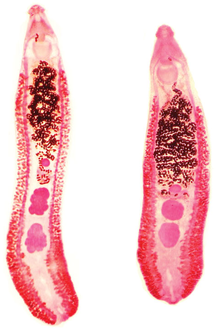
Digenea is a class of trematodes in the Platyhelminthes phylum, consisting of parasitic flatworms with a syncytial tegument and, usually, two suckers, one ventral and one oral. Adults commonly live within the digestive tract, but occur throughout the organ systems of all classes of vertebrates. Once thought to be related to the Monogenea, it is now recognised that they are closest to the Aspidogastrea and that the Monogenea are more closely allied with the Cestoda. Around 6,000 species have been described to date.

The thorny-headed worm family Polymorphidae contains endoparasites which as adults feed mainly in fish and aquatic birds. When this taxon was erected by Meyer in 1931, a subfamily Polymorphinae was established in it. As the Polymorphidae as presently understood would then be monotypic, with no basal genera outside the Polymorphinae, the proposed subfamily is redundant for the time being and therefore most modern treatments simply omit it. Polymorphus minutus is an economically significant parasite in goose and duck farming.

Plagiorchiida is a large order of trematodes, synonymous to Echinostomida. They belong to the Digenea, a large subclass of flukes. This order contains relatively few significant parasites of humans.

Psilostomatidae is a family of trematodes in the order Plagiorchiida. They parasitise aquatic vertebrates as definitive hosts.

Opisthorchiidae is a family of digenean trematodes. Opisthorchiidae have cosmopolitan distribution.

Microcotyle is a genus which belongs to the phylum Platyhelminthes and class Monogenea. Species of Microcotyle are ectoparasites that affect their host by attaching themselves as larvae on the gills of the fish and grow into adult stage. This larval stage is called oncomiracidium, and is characterized as free swimming and ciliated.

Haploporidae is a family of trematodes in the order Plagiorchiida.

Opecoelidae is a family of trematodes. It is the largest digenean family with over 90 genera and nearly 900 species, almost solely found in marine and freshwater teleost fishes. It was considered by Bray et al. to belong in the superfamily Opecoeloidea Ozaki, 1925 or the Brachycladioidea Odhner, 1905.
Telorchiidae is a family of trematode parasites.
Opecoeloides is a genus of trematodes in the family Opecoelidae. It has been synonymised with Cymbephallus Linton, 1934 and Fimbriatus von Wicklen, 1946.
Echinoparyphium elegans is a species of trematode. Intermediate hosts include snails, bivalves, and fish. Definitive hosts are mainly birds and mammals.
Philophthalmidae is a family of trematodes in the order Plagiorchiida.
Echinochasmus is a genus of trematodes in the family Echinochasmidae.
Cathaemasiidae is a family of flatworms belonging to the order Plagiorchiida.

Dicrocoeliidae is a family of flatworms belonging to the order Plagiorchiida.
Cryptogonimidae is a family of trematodes belonging to the order Plagiorchiida.
Derogenidae is a family of trematodes belonging to the order Plagiorchiida.
Hemiuridae is a family of trematodes belonging to the order Plagiorchiida containing 514 described species.

Echinostomatinae is a subfamily of trematodes in the order Plagiorchiida, first described in 1899.











